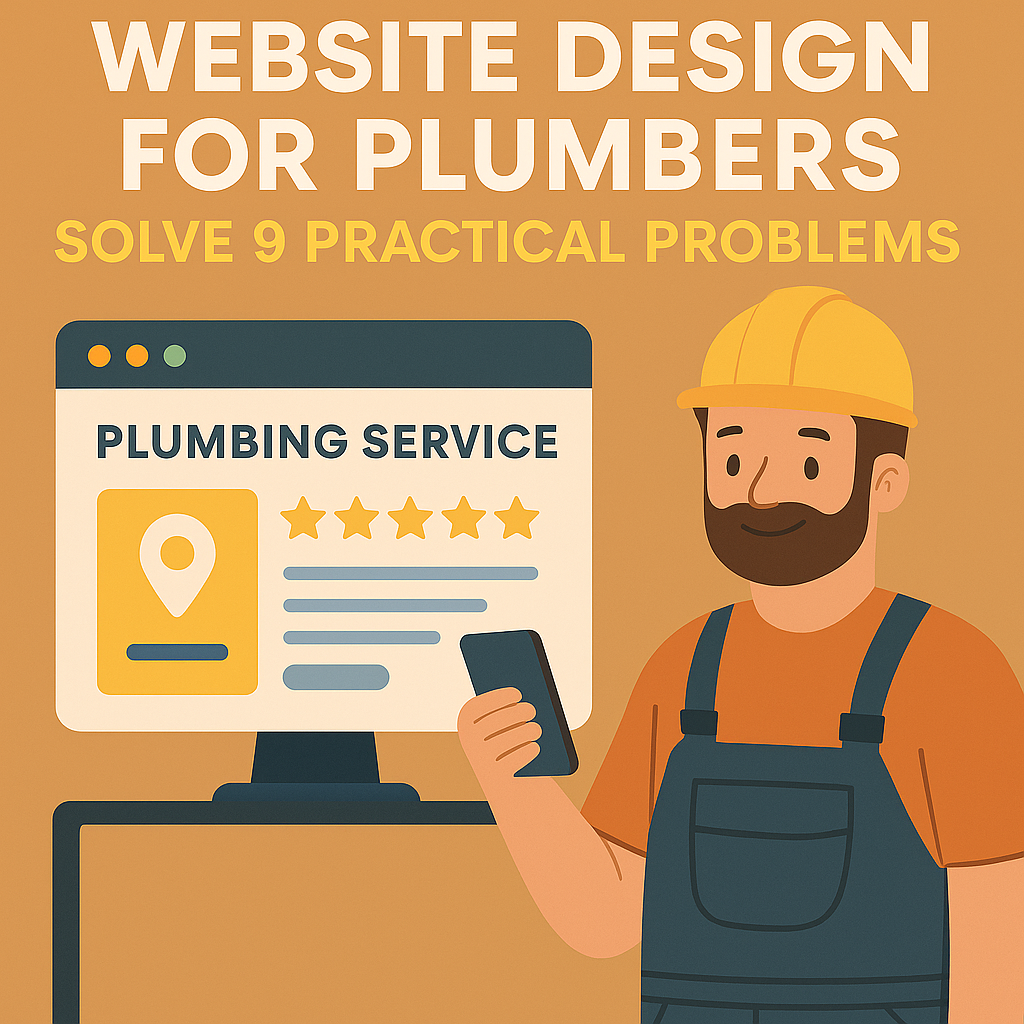Local SEO for builders: How to get your construction business found on Google
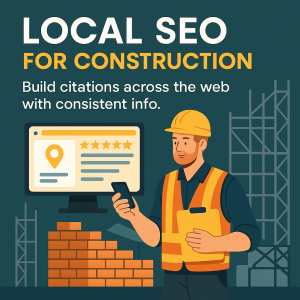
Why Local SEO is Critical for Builders in 2025
For builders, word of mouth is no longer enough. Homeowners and developers don’t keep a list of tradesmen in their back pocket — they search Google. If you don’t appear in the map pack or top results for “builder in [your town],” you’re invisible to potential clients.
Local SEO is about owning your area online. When done right, it puts your business in front of homeowners, landlords, and developers exactly when they’re searching for your services. In this guide, we’ll break down real, detailed strategies builders can use to dominate Google locally — without jargon or fluff.
Mistake 1: Ignoring Your Google Business Profile (GBP)
Why This Matters
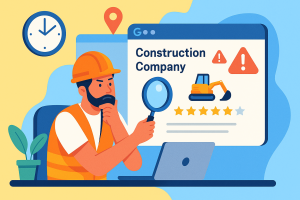
Google Business Profile is free, shows up before websites, and drives the fastest local leads. For many homeowners, it’s the only thing they see before hitting “call.” If you’re not optimised, you’re gifting enquiries to your competitors.
The Problem
Many builders leave their GBP half-empty — no photos, wrong opening hours, no services listed, and barely any reviews. Google sees inactivity and stops showing the profile. Clients see a ghost town and don’t trust it.
The Solution: Optimise GBP Like a Project Portfolio
Here’s exactly how to turn your GBP into a lead magnet:
-
Claim & verify your profile
-
Go to google.com/business.
-
Verify by phone, postcard, or email.
-
Make sure your Name, Address, Phone (NAP) matches your website.
-
-
Set categories properly
-
Primary: Builder.
-
Secondary: add General Contractor, Roofing Contractor, Loft Conversion Specialist, Kitchen Remodeler depending on what you offer.
-
-
Fill in services with keywords
-
Instead of just “Extensions,” write “House Extensions – rear, side, double-storey.”
-
Add service + town in descriptions where natural (e.g., “Garage conversions in Bromley”).
-
-
Upload fresh photos every week
-
Post before-and-after shots, team photos, vans, and completed projects.
-
Always add captions with the service and town (e.g., “Loft conversion completed in Croydon, SE25”).
-
-
Post weekly updates
-
Share progress photos, seasonal offers, or “now booking” messages.
-
Add a CTA like “Book your free survey today.”
-
-
Reviews are non-negotiable
-
After each job, send this text:
“Thanks again for choosing [Business Name]. Could you leave us a quick Google review? It helps homeowners in [Town] find a trusted builder: [short link]”
-
Aim for 50+ reviews per year.
-
-
Enable messaging & call tracking
-
Turn on Google Messaging so clients can text directly.
-
Use a call tracking number to measure results.
-
Pro Tip
Use UTM tags on your GBP website link so you can see exactly how many clicks and leads come from GBP in Google Analytics.
Key Takeaway
Think of GBP as your digital site board. Keep it fresh, full of proof, and packed with reviews, and you’ll own the map results.
Mistake 2: No Local Landing Pages

Why This Matters
Google doesn’t rank “builders in Kent” unless you have a page about builders in Kent. If you want leads in multiple towns, you need dedicated pages for each one.
The Problem
Builders often rely on a single “Services” page that lists everything. That page will only ever rank for one or two terms.
The Solution: Build Location Pages that Actually Rank
Each service + location deserves its own page. Here’s how:
Page Outline Example: Builders in Bromley
-
H1: “Trusted Builders in Bromley”
-
Intro paragraph: 100 words about your experience locally (mention Bromley projects).
-
Project photos: At least 3 real jobs from that area.
-
Service breakdown: Extensions, loft conversions, renovations, etc.
-
Mini case study: “Rear extension in Shortlands, Bromley — completed in 10 weeks.”
-
Pricing guidance: “Extensions in Bromley typically start from £X depending on size.”
-
Trust signals: Reviews from Bromley clients, accreditations.
-
CTA: “Book your free Bromley site survey today.”
-
Embedded Google Map with your service area.
Scaling Tip
-
Build a template for location pages.
-
Swap in unique case studies, photos, and reviews for each town.
-
Start with your top 3 most profitable towns, then expand.
Pro Tip
Don’t copy-paste the same text with different town names — Google will de-rank you. Always use unique local proof (photos, testimonials, pricing notes).
Key Takeaway
If you want to be found in multiple towns, you need multiple town pages — each packed with proof you actually work there.
Mistake 3: Weak On-Site SEO
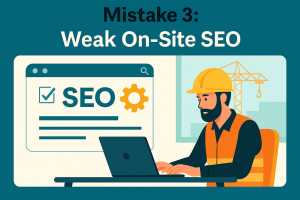
Why This Matters
Even with great photos, if your website doesn’t signal to Google what you do and where, you won’t rank.
The Problem
Common builder SEO fails:
-
No keywords in titles.
-
H1 headers like “Welcome” instead of “Builders in Croydon.”
-
Missing meta descriptions.
-
No schema markup.
The Solution: Optimise Pages Like a Pro
-
Titles
-
Homepage: “Builders in Croydon | Extensions, Lofts & Renovations.”
-
Service page: “Loft Conversions in Croydon – Free Site Survey.”
-
-
Headings (H1/H2)
-
H1: focus keyword (e.g., “Loft Conversions Croydon”).
-
H2s: “Our Loft Conversion Process,” “Costs & Timelines,” “Case Study: Purley.”
-
-
Meta descriptions
-
“Looking for a trusted builder in Bromley? We specialise in extensions, lofts, and renovations. Call today for a free survey.”
-
-
Schema
-
Add LocalBusiness + FAQ schema for rich snippets.
-
-
Internal links
-
Link location pages together: “Looking for loft conversions in Bromley? See our Croydon projects.”
-
Pro Tip
Install Rank Math or Yoast SEO to manage titles, descriptions, and schema.
Key Takeaway
Make it stupidly obvious to Google who you are, what you do, and where.
Mistake 4: Forgetting Mobile Users
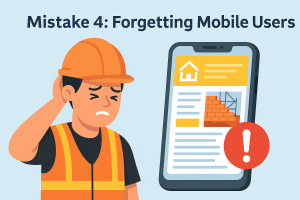
Why This Matters
Over 70% of construction searches happen on phones. If your site is slow or confusing, people leave.
The Solution: Mobile-First Fixes
-
Fast hosting – don’t use £1/month shared hosting.
-
Image compression – use ShortPixel to reduce load size.
-
Sticky call button – “Call Now” button fixed at bottom of mobile screens.
-
Responsive design – test every page on your own phone.
Pro Tip
Run your site through PageSpeed Insights. Fix the slowest pages first.
Mistake 5: Ignoring Reviews & Trust Signals
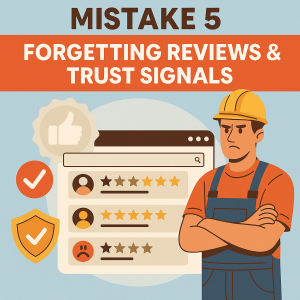
Why This Matters
Building is high-ticket. No reviews = no trust.
The Solution: Build a Reputation Engine
-
Systemise reviews – text/email every client after completion with review link.
-
Show reviews on-site – use a plugin to display live Google reviews.
-
Highlight certifications – FMB, TrustMark, Gas Safe, NICEIC, insurance logos.
-
Case studies – write short 150-word breakdowns of projects with photos.
Pro Tip
Video testimonials convert 2–3x better than written reviews. Record on your phone — no need for fancy editing.
Bonus Section: Your 14-Day Local SEO Sprint
-
Day 1–2: Claim & optimise GBP.
-
Day 3–5: Publish 1 location landing page.
-
Day 6–7: Compress images + add sticky CTA.
-
Day 8–10: Collect 3 new reviews.
-
Day 11–12: Add schema to your homepage.
-
Day 13–14: Write a blog post answering a local question: “How much does a house extension cost in Croydon?”
Conclusion
Local SEO isn’t optional in 2025. Builders who own their Google presence dominate local search, while others vanish. By optimising your GBP, creating local landing pages, fixing on-site SEO, and systemising reviews, you make it easy for clients to find you, trust you, and contact you.
Start today by updating your Google Business Profile and publishing your first town page. Within weeks, you’ll see the difference in calls and enquiries.

